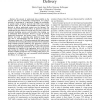Free Online Productivity Tools
i2Speak
i2Symbol
i2OCR
iTex2Img
iWeb2Print
iWeb2Shot
i2Type
iPdf2Split
iPdf2Merge
i2Bopomofo
i2Arabic
i2Style
i2Image
i2PDF
iLatex2Rtf
Sci2ools
ICNS
2008
IEEE
2008
IEEE
Towards QoS Improvements of TCP-Based Media Delivery
—The amount of audiovisual data available on the Internet and thus of multimedia communication over today’s networks is increasing at a rapid pace. Despite the availability of specific media transport protocols like RTP, most content providers make use of the well-established and reliable TCP protocol to deliver audiovisual content over the Internet. The reason is that TCP-based data delivery in general is much less complicated for the clients to be served and over today’s networks traversed (including proxies and firewalls), than making use of UDP-based RTP connections. However, in case of network bandwidth fluctuations and packet losses, TCP-based media delivery may lead to annoying jerky playback at the client side, due to retransmissions and late arrival of media data. This papers deals with TCP-based perceptual QoS improvement mechanisms for increasing the media experience for the consumer under unstable network conditions. Our approach is based on media content adaptatio...
Computer Networks | ICNS 2008 | TCP-based Data Delivery | TCP-based Media Delivery | Today’s Networks |
Related Content
| Added | 30 May 2010 |
| Updated | 30 May 2010 |
| Type | Conference |
| Year | 2008 |
| Where | ICNS |
| Authors | Martin Prangl, Ingo Kofler, Hermann Hellwagner |
Comments (0)

